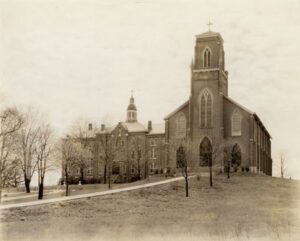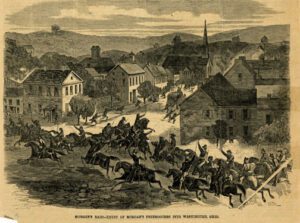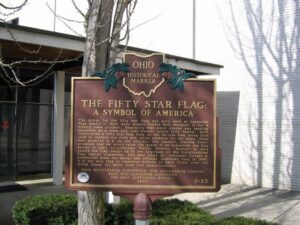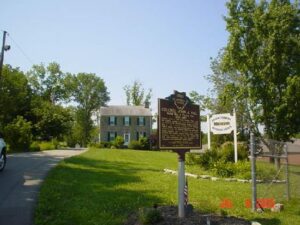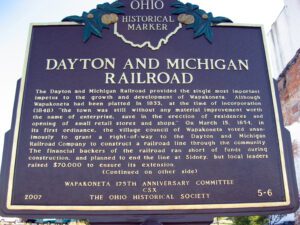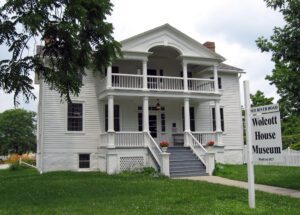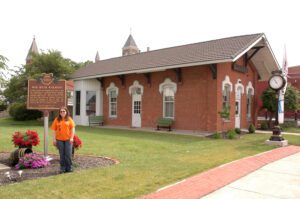, OH
St. Joseph Catholic Church, called the cradle of the faith in Ohio, was the first Catholic church in the state. In 1809, Jacob and Catharine Dittoe deeded Father Edward Fenwick, who had traveled from Kentucky, 320 acres of ground to build the church. The original church, dedicated on December 6, 1818, by Father Fenwick and Father Nicholas Dominic Young, was a log cabin with a bare dirt floor measuring 18 feet by 22 feet. Father Fenwick was soon installed as the first Bishop of Cincinnati. Construction on the present church began in 1839.
, OH
General John Hunt Morgan of Kentucky led a force of Confederate calvarymen into Meigs County during a forty-six day raid north of the Ohio River. The advance forces burned Benjamin Knight’s carding mill and sawmill, the Shade River Bridge, and pillaged local businesses in Chester on July 18, 1863, while waiting for the rest of the column to catch up. This two-hour halt delayed General Morgan’s arrival at the ford at Buffington Island until after dark, allowing Union troops to arrive before he could make his escape. General Morgan surrendered eight days later near West Point in Columbiana County, the northernmost point ever reached by Confederate forces during the Civil War.
, OH
The design for the fifty star flag was born here at Lancaster High School in 1958 when student Robert Heft designed it for a history class project. Reasoning that since Alaska was seeking admission as a state and that Hawaii would soon follow, Heft constructed a fifty star flag from an old 48-star flag using blue cloth to replace the field and white adhesive for the stars. When Heft received a B- on his project, his teacher, Stanley Pratt, promised that he would raise the grade if he submitted the flag design to their congressman, Walter Moeller. Moeller in turn passed the flag design on to the chairman of the Congressional Flag Design Committee, who also liked it. President Dwight D. Eisenhower made the design the official American flag in 1960. It is the only flag in American history to have flown over the White House for more than five administrations.
, OH
Colonel John J. Voll from Goshen, Ohio, was the highest scoring ace of the 15th U.S. Army Air Force in the Mediterranean theater of World War II. As a Captain flying a P-51 Mustang fighter plane, he was credited with twenty-one aerial victories. His superior skill in one particular battle enabled him to maneuver three enemy aircraft into crashes without firing a shot. On a separate mission, while flying solo, Captain Voll had four confirmed kills, two probables, and damaged two additional enemy planes. (continued on other side)
, OH
The Dayton and Michigan Railroad provided the single most important impetus to the growth and development of Wapakoneta. Although Wapakoneta had been platted in 1833, at the time of incorporation (1848), “the town was still without any material improvement worth the name of enterprise, save in the erection of residences and opening of small retail stores and shops.” On March 15, 1854, in its first ordinance, the village council of Wapakoneta voted unanimously to grant a right-of-way to the Dayton and Michigan Railroad Company to construct a railroad line through the community. The financial backers of the railroad ran short of funds during construction, and planned to end the line at Sidney, but local leaders raised $70,000 to ensure its extension. (Continued on other side)
, OH
This federal style house was built in 1827 by James A. Wolcott who migrated to Ohio in 1818 from Connecticut. Of distinguished parentage, Wolcott was a leading merchant, shipbuilder, judge and politician. Here he and his wife, Mary Wells, daughter of scout William Wells and Sweet Breeze, Indian Chief Little Turtle’s daughter, made their home a center of frontier activity. This house stands as a tangible symbol of this Maumee pioneer, a Registered National Historic Place.
, OH
In 1832 a charter was granted by the state of Ohio for construction of a railroad between Sandusky City and Dayton. The right-of-way privileges included Hardin County. The first train, of the Mad River and Lake Erie Railroad, arrived in Kenton from Sandusky on July 14, 1846. The railroad was completed to Dayton in 1851. The depot on this site was erected in 1882.
, OH
On this site in October of 1870 met a group of enlightened individuals dedicated to the reformation and improvement of penal systems. This first Congress of the National Prison Association, now known as the American Correctional Association, adopted a far-sighted philosophy of corrections. This philosophy, embodied in its Declaration of Principles, remains today as the basic guide for modern correctional systems.


